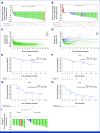Efficacy and Safety of Taletrectinib in Chinese Patients With ROS1+ Non-Small Cell Lung Cancer: The Phase II TRUST-I Study
- PMID: 38822758
- PMCID: PMC11272140
- DOI: 10.1200/JCO.24.00731
Efficacy and Safety of Taletrectinib in Chinese Patients With ROS1+ Non-Small Cell Lung Cancer: The Phase II TRUST-I Study
Abstract
Purpose: Taletrectinib, a highly potent, CNS-active, ROS1 tyrosine kinase inhibitor (TKI), has demonstrated high and durable response rates, high intracranial objective response rate (ORR), prolonged progression-free survival (PFS), and activity against G2032R with a favorable safety profile. We report outcomes from the pivotal TRUST-I study (ClinicalTrials.gov identifier: NCT04395677) of taletrectinib for ROS1+ non-small cell lung cancer in China.
Methods: TRUST-I evaluated TKI-naїve and crizotinib-pretreated patients. The primary end point was confirmed ORR (cORR) by independent review committee; key secondary end points included duration of response (DOR), PFS, and safety.
Results: As of November 2023, 173 patients were enrolled (median age, 55 years; 58% female; 73% never smoked; TKI naїve: n = 106; crizotinib pretreated: n = 67). In TKI-naїve patients, cORR and intracranial cORR were 91% and 88%, respectively, and 52% and 73% in crizotinib-pretreated patients. In TKI-naїve patients, median DOR and median PFS were not reached (NR) with 22.1-month and 23.5-month follow-up, respectively. In crizotinib-pretreated patients, the median DOR was 10.6 months (95% CI, 6.3 months to NR; 8.4-month follow-up), and the median PFS was 7.6 months (95% CI, 5.5 to 12.0 months; 9.7-month follow-up). Eight of 12 patients (67%) with G2032R mutations responded. The most frequent treatment-emergent adverse events (TEAEs) were increased AST (76%), diarrhea (70%), and increased ALT (68%), most of which were grade 1-2. Incidences of neurologic TEAEs were low (dizziness: 23%; dysgeusia: 10%) and mostly grade 1. Discontinuations (5%) and dose reductions (19%) due to TEAEs were low.
Conclusion: Taletrectinib continues to show high and durable overall responses, prolonged PFS, robust activity against intracranial lesions and acquired resistance mutations including G2032R, and a favorable safety profile with a low incidence of neurologic TEAEs.
Conflict of interest statement
The following represents disclosure information provided by authors of this manuscript. All relationships are considered compensated unless otherwise noted. Relationships are self-held unless noted. I = Immediate Family Member, Inst = My Institution. Relationships may not relate to the subject matter of this manuscript. For more information about ASCO's conflict of interest policy, please refer to
Open Payments is a public database containing information reported by companies about payments made to US-licensed physicians (
No other potential conflicts of interest were reported.
Figures




Comment in
-
Taletrectinib: TRUST in the Continued Evolution of Treatments for ROS1 Fusion-Positive Lung Cancer.J Clin Oncol. 2024 Aug 1;42(22):2622-2627. doi: 10.1200/JCO.24.01062. Epub 2024 Jun 28. J Clin Oncol. 2024. PMID: 38941567 Free PMC article.
References
-
- Ettinger DS, Wood DE, Aisner DL, et al. : NCCN guidelines insights: Non-small cell lung cancer, version 2.2021. J Natl Compr Canc Netw 19:254-266, 2021 - PubMed
-
- Xalkori [package insert]. New York, NY, Pfizer, 2023
-
- Gainor JF, Tseng D, Yoda S, et al. : Patterns of metastatic spread and mechanisms of resistance to crizotinib in ROS1-positive non-small-cell lung cancer. JCO Precis Oncol 10.1200/PO.17.00063 - DOI - PMC - PubMed
Publication types
MeSH terms
Substances
Associated data
LinkOut - more resources
Full Text Sources
Medical
Research Materials

